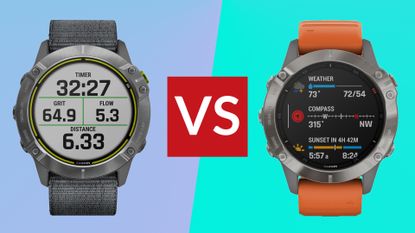Garmin Enduro vs Garmin Fenix 6: the ultimate battle of big-ticket, big-screen, big-everything multisport watches from Garmin.
In this Garmin Enduro vs Garmin Fenix 6 comparison, we'll look at all the key features, design, build quality, accuracy and price of these capable running watches to help you decide which is best for you.
Despite the similar looks, there are some key differences between the new Garmin Enduro and the Garmin Fenix 6. These differences expand beyond the 'Enduro has a longer battery life' argument, and once you look at all the stats and features, the main benefits of using either shine through.
One thing is for sure: the Enduro and the Fenix 6 belong on the best Garmin watch guide, for one reason or another.
Looking for the best running watch from Garmin that doesn't cost the earth? We recommend the high-end Garmin Forerunner 945 or the mid-range Garmin Forerunner 245. For triathletes, the Garmin Forerunner 745 has all the features an athlete might need for a sub-£500/$500 price tag.
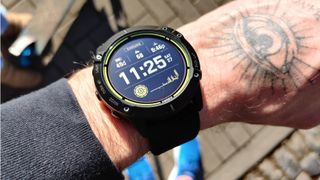
Garmin Enduro features solar charging
Garmin Enduro vs Garmin Fenix 6: Main features
The Garmin Enduro is a watch designed for endurance trail runners. It offers specific features tailored to them on top of the 'usual stuff' you'd expect from a Garmin watch.
The Enduro-specific features include the new 'augmented' trail features such as 'Trail Run VO2 Max', which is based on running performance related to trail conditions and adjusted to the environment through heat and altitude acclimation, 'ClimbPro Trail Enhancements', which allows you to get real-time information on the current and upcoming climbs including gradient, distance and elevation gain and 'Rest Timer', which features a rest timer to log the time spent at aid stations in Ultrarun mode.
The Garmin Fenix 6 has offline TOPO maps and point-of-interest navigation, can store offline music (it has 32GB of memory as opposed to the Enduro's 64MB) and supports a WiFi connection for quicker updates. To further reinforce the multisport-cum-adventure watch nature of the Fenix 6, it has hiking, golfing, and ski-resort maps on the watch, too, something the trail-running specialist Enduro lacks.
Both watches feature a range of casual features such as Body Battery "energy management", sleep tracking, Pulse Ox blood-oxygen sensor, ABC sensors, weather widgets, smart notifications etc.
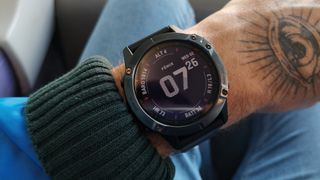
Garmin Fenix 6 has 29 different models to choose from
Garmin Enduro vs Garmin Fenix 6: Design
The Garmin Fenix 6 has no fewer than 29 different versions, including the Fenix 6S (42 mm case), the Fenix 6 (47 mm case) and Fenix 6X models (51 mm case). All three versions can be bought with or without 'premium features', which include Trendline Popularity Routing, PacePro, ski maps and the ability to preload music. All three versions are available in 'Standard', 'Sapphire' and 'Solar' versions, where Sapphire editions feature a scratch-resistant sapphire lens. The Solar editions have Power Glass lenses that turn sunlight into energy, so your battery life is extended. There is a Fenix 6 model for everyone.
The user interface and the navigation are essentially the same on both watches. This includes a five-button layout and a customisable widget-view menu on the watch.
So it's refreshing by Garmin standards that the Enduro is only available in a mere two different versions. You can get the watch with stainless steel, or Diamond-Like Carbon (DLC) coated titanium bezel. Under the hood, both versions are essentially the same, but the DLC coated titanium version is slightly lighter than the stainless steel variety (titanium: 52 grams, stainless steel: 66 grams, both case-only weight).
The Enduro sports an "ultra-lightweight elastic nylon hook and loop" strap, which is said to provide a better fit than standard silicone straps. Given the watch's size, it's great that the strap hasn't got 'stops' and can be adjusted precisely to any wrist size, so it hugs the wrist better. The Enduro features solar charging, extending battery life further as long as you expose the watch to adequate sunlight.
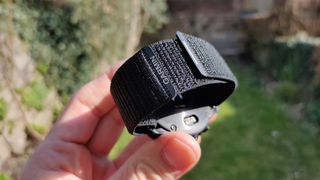
Garmin Enduro's 'ultra-lightweight elastic nylon hook and loop' strap
Garmin Enduro vs Garmin Fenix 6: Battery life
The Garmin Enduro's battery life is just unbelievable. It will function between two charges for up to 50 days (65 days with solar) in 'smartwatch mode' (with GPS turned off), up to 130 days (1 year with solar) in Battery Saver Mode, up to 70 hours (80 hours with solar) in GPS mode (e.g. tracking outdoor runs), up to 200 hours (300 hours with solar) in Max Battery GPS Mode and finally, up to 65 days (95 days with solar) in Expedition GPS Activity Mode.
These numbers are bonkers for a running watch with such a massive screen as the Enduro has. The Suunto 9 used to be the gold standard for extended battery life with its 'Ultra mode', although that mode turns off every sensor apart from the GPS, while the Enduro will track HR etc., in GPS mode.
The Garmin Fenix 6 has excellent battery life, but the numbers are not as impressive as the Enduro's. Up to 14 days in 'smartwatch mode', up to 48 days in Battery Saver Mode, up to 36 hours in GPS mode, up to 72 hours in Max Battery GPS Mode and up to 28 days in Expedition GPS Activity Mode. The Fenix 6 also has a 'GPS and music' battery life which is a measly 10 hours, but this uses all the sensors plus the Bluetooth to listen to your music directly from the watch.
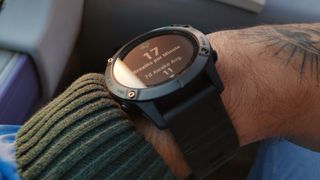
The Garmin Fenix 6 features class-leading a heart rate sensor and GPS
Garmin Enduro vs Garmin Fenix 6: Accuracy
Both watches use the same best-in-class sensors, including the Elevate V3 heart rate sensor and the Sony GNSS chipset. The latter can access multiple global navigation satellite systems (GPS, GLONASS and Galileo) to track in "more challenging environments" than GPS alone.
Garmin's Elevate sensor is exceptionally accurate in higher heart rate zones, but it is worth mentioning that the algorithm might overestimate heart rates in lower heart rate zones. The watches will also track location more accurately when you move faster (e.g. run instead of walking). Garmins are sports watches, and the algorithm is tailored to be as accurate as possible for higher intensity activities.
This doesn't mean they are grossly inaccurate in low heart rate zones, but they might not match the accuracy of the Apple Watch Series 6 when tracking heart rate standing still. Garmins won't be way off, just slightly.
Garmin Enduro vs Garmin Fenix 6: Price and availability
The Garmin Enduro is available to buy now at Garmin US and Garmin UK. It comes in two versions: the standard Enduro features a steel bezel and costs $799.99 / £699.99 while the more premium Carbon Grey DLC Titanium version is $899.99 / £799.99.
The Garmin Fenix 6 is also available to buy now at Garmin US and Garmin UK. Prices start from $549.99 / £529.99 for the Standard 6S version without the premium features and go all the way up to $1,099.99 / £849.99, the amount of money you have to pay for a Garmin Fenix 6X Pro Solar Edition.
For the best prices, have a look at the best Garmin watch deals roundup: prices are updated every half an hour and are based on your location!
